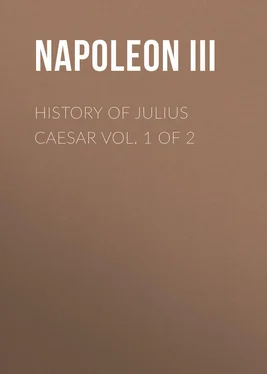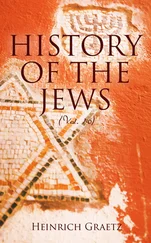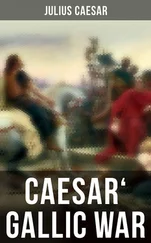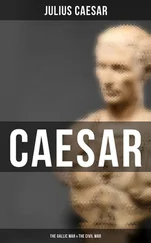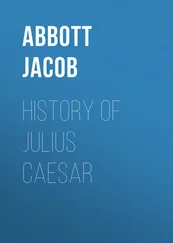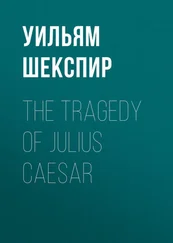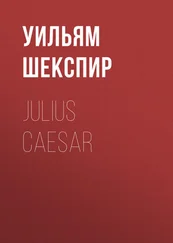Napoleon III - History of Julius Caesar Vol. 1 of 2
Здесь есть возможность читать онлайн «Napoleon III - History of Julius Caesar Vol. 1 of 2» — ознакомительный отрывок электронной книги совершенно бесплатно, а после прочтения отрывка купить полную версию. В некоторых случаях можно слушать аудио, скачать через торрент в формате fb2 и присутствует краткое содержание. Жанр: foreign_antique, foreign_prose, Биографии и Мемуары, на английском языке. Описание произведения, (предисловие) а так же отзывы посетителей доступны на портале библиотеки ЛибКат.
- Название:History of Julius Caesar Vol. 1 of 2
- Автор:
- Жанр:
- Год:неизвестен
- ISBN:нет данных
- Рейтинг книги:5 / 5. Голосов: 1
-
Избранное:Добавить в избранное
- Отзывы:
-
Ваша оценка:
- 100
- 1
- 2
- 3
- 4
- 5
History of Julius Caesar Vol. 1 of 2: краткое содержание, описание и аннотация
Предлагаем к чтению аннотацию, описание, краткое содержание или предисловие (зависит от того, что написал сам автор книги «History of Julius Caesar Vol. 1 of 2»). Если вы не нашли необходимую информацию о книге — напишите в комментариях, мы постараемся отыскать её.
History of Julius Caesar Vol. 1 of 2 — читать онлайн ознакомительный отрывок
Ниже представлен текст книги, разбитый по страницам. Система сохранения места последней прочитанной страницы, позволяет с удобством читать онлайн бесплатно книгу «History of Julius Caesar Vol. 1 of 2», без необходимости каждый раз заново искать на чём Вы остановились. Поставьте закладку, и сможете в любой момент перейти на страницу, на которой закончили чтение.
Интервал:
Закладка:
Trapezus ( Trebizonde ), which before the time of Mithridates the Great preserved a sort of autonomy under the kings of Pontus, had an extensive commerce; which was the case also with another Greek colony, Amisus ( Samsoun ), 351regarded in the time of Lucullus as one of the most flourishing and richest towns in the country. 352In the interior, Amasia, which became afterwards one of the great fortresses of Asia Minor, and the metropolis of Pontus, had already probably, at the time of the Punic wars, a certain renown. Cabira, called afterwards Sebaste , and then Neocæsarea, the central point of the resistance of Mithridates the Great to Lucullus, owed its ancient celebrity to its magnificent Temple of the Moon. From the country of Cabira, there was, according to the statement of Lucullus, 353only the distance of a few days’ march into Armenia, a country the riches of which may be estimated by the treasures gathered by Tigranes. 354
We can hence understand how Mithridates the Great was able, two centuries later, to oppose the Romans with considerable armies and fleets. He possessed in the Black Sea 400 ships, 355and his army amounted to 250,000 men and 40,000 horse. 356He received, it is true, succours from Armenia and Scythia, from the Palus Mæotis, and even from Thrace.
Bithynia.
XI. Bithynia, a province of Asia Minor, comprised between the Propontis, the Sangarius, and Paphlagonia, formed a kingdom, which, at the beginning of the sixth century of Rome, was adjacent to Pontus, and comprised several parts of the provinces contiguous to Mysia and Phrygia. In it were found several towns, the commerce of which rivalled that of the maritime towns of Pontus, and especially Nicæa and Nicomedia. This last, founded in 475 by Nicomedes I., took a rapid extension. 357Heraclea Pontica, a Milesian colony situated between the Sangarius and the Parthenius, preserved its extensive commerce, and an independence which Mithridates the Great himself could not entirely destroy; it possessed a vast port, safe and skilfully disposed, which sheltered a numerous fleet. 358The power of the Bithynians was not insignificant, since they sent into the field, in the war of Nicomedes against Mithridates, 56,000 men. 359If the traffic was considerable on the coasts of Bithynia, thanks to the Greek colonies, the interior was not less prosperous by its agriculture, and Bithynia was still, in the time of Strabo, renowned for its herds. 360
One of the provinces of Bithynia fell into the hands of the Gauls (A.U.C. 478). Three peoples of Celtic origin shared it, and exercised in it a sort of feudal dominion. It was called Galatia from the name of the conquerors. Its places of commerce were: Ancyra, the point of arrival of the caravans coming from Asia, and Pessinus, one of the chief seats of the old Phrygian worship, where pilgrims repaired in great number to adore Cybele. 361The population of Galatia was certainly rather considerable, since in the famous campaign of Cneius Manlius Volso, 362in 565, the Galatians lost 40,000 men. The two tribes united of the Tectosagi and Trocmi raised at that period, in spite of many defeats, an army of 50,000 foot and 10,000 horse. 363
Cappadocia.
XII. To the east of Galatia, Cappadocia comprised between the Halys and Armenia, distant from the sea, and crossed by numerous chains of mountains, formed a kingdom which escaped the conquests of Alexander, and which, a few years after his death, opposed Perdiccas with an army of 30,000 footmen and 15,000 horsemen. 364In the time of Strabo, wheat and cattle formed the riches of this country. 365In 566, King Ariarathes paid 600 talents for the alliance of the Romans. 366Mazaca (afterwards Cæsarea ), capital of Cappadocia, a town of an entirely Asiatic origin, had been, from a very early period, renowned for its pastures. 367
Kingdom of Pergamus.
XIII. The western part of Asia Minor is better known. It had seen, after the battle of Ipsus, the formation of the kingdom of Pergamus, which, thanks to the interested liberality of the Romans towards Eumenes II., increased continually until the moment when it fell under their sovereignty. To this kingdom belonged Mysia, the two Phrygias, Lycaonia, and Lydia. This last province, crossed by the Pactolus, had for its capital Ephesus, the metropolis of the Ionian confederation, at the same time the mart of the commerce of Asia Minor and one of the localities where the fine arts were cultivated with most distinction. This town had two ports: one penetrated into the heart of the town, while the other formed a basin in the very middle of the public market. 368The theatre of Ephesus, the largest ever built, was 660 feet in diameter, and was capable of holding 60,000 spectators. The most celebrated artists, Scopas, Praxiteles, etc., worked at Ephesus upon the great Temple of Diana. This monument, the building of which lasted two hundred and twenty years, was surrounded by 128 columns, each 60 feet high, presented by so many kings. Pergamus, the capital of the kingdom, passed for one of the finest cities in Asia, longe clarissimum Asiæ Pergamum , says Pliny; 369the port of Elæa contained maritime arsenals, and could arm numerous vessels. 370The acropolis of Pergamus, an inaccessible citadel, defended by two torrents, was the residence of the Attalides; these princes, zealous protectors of the sciences and arts, had founded in their capital a library of 200,000 volumes. 371Pergamus carried on a vast traffic; its cereals were exported in great quantities to most places in Greece. 372Cyzicus, situated on an island of the Propontis, with two closed ports forming a station for about two hundred ships, 373rivalled the richest cities of Asia. Like Adramyttium, it carried on a great commerce in perfumery, 374it worked the inexhaustible marble-quarries of the island of Proconnesus, 375and its commercial relations were so extensive that its gold coins were current in all the Asiatic factories. 376The town of Abydos possessed gold mines. 377The wheat of Assus was reputed the best in the world, and was reserved for the table of the kings of Persia. 378
We may estimate the population and resources of this part of Asia from the armies and fleets which the kings had at their command at the time of the conquest of Greece by the Romans. In 555, Attalus II., and, ten years later, Eumenes II., sent them numerous galleys of five ranks of oars. 379The land forces of the kings of Pergamus were much less considerable. 380Their direct authority did not extend over a great territory, yet they had many tributary towns; hence their great wealth and small army. The Romans drew from this country, now nearly barren and unpeopled, immense contributions both in gold and wheat. 381The magnificence of the triumph of Manlius and the reflections of Livy, compared with the testimony of Herodotus, reveal all the splendour of the kingdom of Pergamus. It was after the war against Antiochus and the expedition of Manlius that extravagance began to display itself at Rome. 382Soldiers and generals enriched themselves prodigiously in Asia. 383
The ancient colonies of Ionia and Æolis, such as Clazomenæ, Colophon, and many others, which were dependent for the most part on the kingdom of Pergamus, were fallen from their ancient grandeur. Smyrna, rebuilt by Alexander, was still an object of admiration for the beauty of its monuments. The exportation of wines, as celebrated on the coast of Ionia as in the neighbouring islands, formed alone an important support of the commerce of the ports of the Ægean Sea.
The treasures of the temple of Samothrace were so considerable, that we are induced to mention here a circumstance relating to this little island, though distant from Asia, and near the coast of Thrace: Sylla’s soldiers took in the sanctuary the Cabiri, an ornament of the value of 1,000 talents (5,820,000 francs [£232,800]). 384
Читать дальшеИнтервал:
Закладка:
Похожие книги на «History of Julius Caesar Vol. 1 of 2»
Представляем Вашему вниманию похожие книги на «History of Julius Caesar Vol. 1 of 2» списком для выбора. Мы отобрали схожую по названию и смыслу литературу в надежде предоставить читателям больше вариантов отыскать новые, интересные, ещё непрочитанные произведения.
Обсуждение, отзывы о книге «History of Julius Caesar Vol. 1 of 2» и просто собственные мнения читателей. Оставьте ваши комментарии, напишите, что Вы думаете о произведении, его смысле или главных героях. Укажите что конкретно понравилось, а что нет, и почему Вы так считаете.
